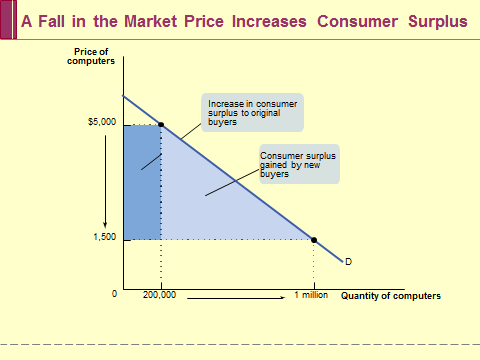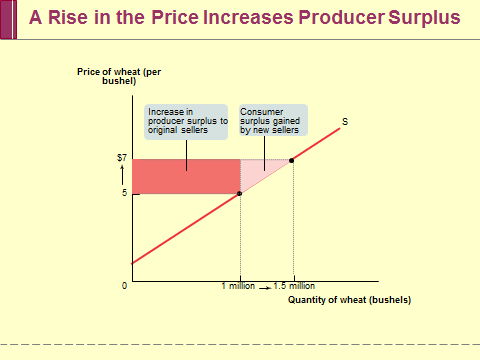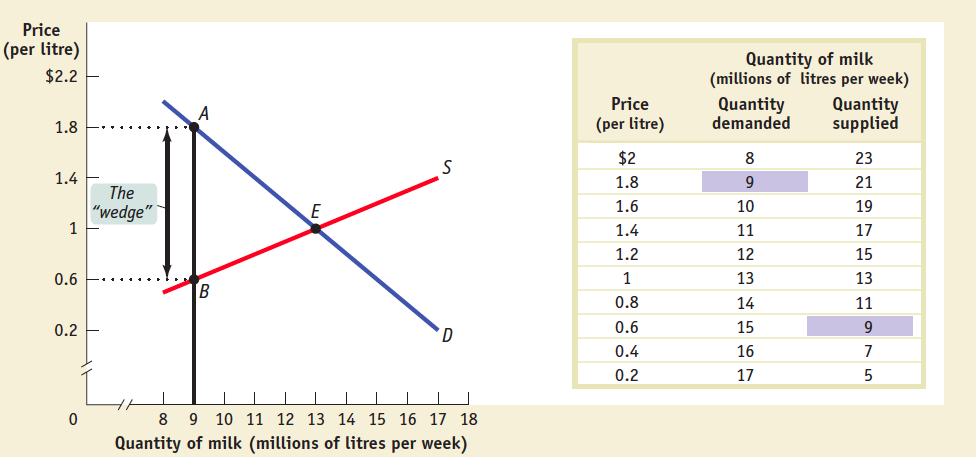
- •Fundamental Economic Principles and Economic Models. Фундаментальные принципы экономики и экономические модели.
- •Supply and Demand. Спрос и предложение.
- •Consumer and Producer Surplus. Market Reaction to Government Intervention. Излишек потребителя и производителя. Реакция рынка на вмешательство правительства.
- •Elasticity. Эластичность.
- •Theory of Consumer Behavior and Rational Choice. Теория потребительского поведения и рационального выбора.
- •Basic Economic Theory of Risk. Expected Utility Function, Risk Premium and Risk Aversion Measures. Основы экономической теории риска. Функция ожидаемой полезности. Премия риска и избегание риска.
- •Profit Maximization and Theory of Firm and Industry Supply. Максимизация прибыли и теория предложения фирмы и отрасли.
- •Production Costs in Short Run vs. Long Run. Производственные затраты в краткосрочном и долгосрочном периоде.
- •The Model of Perfect Competition. Модель совершенной конкуренции.
- •The Theory of Monopoly. Теория монополии.
- •Oligopoly and Game Theory. Олигополия и теория игр.
- •Monopolistic Competition. Монополистическая конкуренция.
- •The Economic Theory of Taxation. Экономическая теория налогообложения.
- •The Economics of Welfare State. Экономика государства всеобщего благоденствия.
- •Externalities and Transaction Costs. Экстерналии и транзакционные затраты.
- •Public Goods, Common Resources, and Artificially Scarce Goods. Общественные товары, общие ресурсы и искусственно редкие товары.
- •Information Asymmetry. Adverse Selection and Moral Hazard. Информационная асимметрия. Враждебный выбор и моральный ущерб.
- •Aggregate Demand and Aggregate Supply. Model ad-as. Совокупный спрос и совокупное предложение.
- •Consumption, Savings, and Investments. Income and Expenditure. "Keynesian Cross". Потребление, сбережение. Инвестирование. Доход-затраты. Кейнсианский крест.
- •Long Run Economic Growth. Долгосрочный экономический рост.
- •The Theories of Business Cycles. Теории экономических циклов.
- •Inflation, Disinflation, and Deflation. Инфляция, Дизинфляция и Дефляция.
- •Unemployment and Inflation. Безработица и инфляция.
- •Fiscal Policy. Фискальная политика.
- •Monetary Policy. Монетарная политика.
- •28. The Theories of International Trade. Теории международной торговли.
- •29. Open Economy Macroeconomics. (Balance of Payments, Exchange Rates, ppp). Открытая экономика (платежный баланс, обменные курсы валют, ппс)
- •30. The composition of the global financial market: instruments, participants, sources of information. Состав глобального финансового рынка: инструменты, участники, источники информации.
- •32. Types of banks and their role in the international financial market. Типы банков и их роль на международном финансовом рынке.
- •33. The global equities market: size, indicators, principles of organization. Глобальный рынок капитала: размер, индикаторы, принципы организации.
- •34. The global debt securities market: types, composition, principles of organization. Глобальный долговой рынок ценных бумаг: типы ценных бумаг, состав, принципы организации.
- •36. The government bond markets: size, composition, significance. Рынки правительственных облигаций: размер, состав, значение.
- •37. Rating agencies and their role in the global financial market. Рейтинговые агентства и их роль и значение на глобальном финансовом рынке.
- •38. Types of institutional investors and their role in the global financial markets. Типы институциональных инвесторов и их роль на мировых финансовых рынках.
- •39. The functions of the international financial organizations (imf, World Bank, bis). Функции международных финансовых организаций (мвф, Всемирный банк, Банк международных расчетов.)
- •International trade financing: International banks are the leading source of credit for multinational corporations and many governmental units. They provide both st & lt financing.
- •41. Fighting International Money Laundering and Offshore Banking Markets. Борьба с международным отмыванием денег и оффшорные банковские рынки.
- •42. Mergers and Acquisitions in Financial Services Markets. Слияния поглощения на рынках финансовых услуг.
- •43. International Financial Centers. Международные финансовые центры.
- •46. European Stability Mechanism and Fiscal Compact. Европейский стабилизационный механизм и пакт о финансовой стабильности и росте.
- •47. European Debt Crisis, us Fiscal Cliff, and Federal Budget Sequester. Европейский долговой кризис. Фискальный обрыв и секвестр федерального бюджета сша.
- •48. Wto and the problems of the Russian Federation participation in it. Вто и проблемы участия в ней рф.
- •50. Stabilization Funds. Стабилизационные фонды.
- •51. Necessity and preconditions of Appearance and Applications of Moneys. Evolution of Forms and Types of Moneys.Необходимость и предпосылки появления и применения денег. Эволюция форм и видов денег.
- •52. The Problem of Money Supply Measurements in Modern Economy. The Specifics of Russia.Проблемы измерения денежной массы в современной экономике. Особенности России.
- •53. Monetary Emission and Printing Money.Выпуск денег в хозяйственный оборот и денежная эмиссия.
- •54. Modern Basics of Cash at Bank monetary Circulation: Russian Specifics. Современные основы организации безналичного денежного оборота: особенности России.
- •55. The Development of Forms of Credit and their Role in Modern Economy. Развитие форм кредита и их роль в современной экономике России.
- •56. Economic Foundations of Forming the Level of Loan Interest and its Role in the Market Economy.Экономические основы формирования уровня ссудного процента и его роль в рыночной экономике.
- •57. The Conditions and Specifics of Modern Banking System in Russia. Состояние и особенности развитие современной банковской системы России.
- •58. The Role of Banks and Non-Banking Credit Organization in Modern Market Economy in Russia.Роль банков и небанковских кредитных организаций в современной рыночной экономике России.
- •61. Classified Financial Statements and Ratios. Corporate Financial Statements. Классифицированные финансовые отчеты и показатели. Корпоративная финансовая отчетность.
- •62. Merchandising Operations. Merchandising Income Statement. Inventories. Торговые операции. Отчет о прибыли торговой организации. Товарные запасы.
- •63. Internal Control. Внутренний контроль.
- •64. Cash and Receivables. Денежные средства и дебиторская задолженность.
- •65. Short-Term Investments, Long-Term Investments (Debt, Equity). Краткосрочные инвестиции. Долгосрочные инвестиции (долг, капитал).
- •66. Current Liabilities. Текущие обязательства.
- •67. Long Term Liabilities. Долгосрочные обязательства.
- •68. Long Term Assets. Долгосрочные активы.
- •69. Contributed Capital. Акционерный капитал.
- •Cash Flow Statement. Отчет о движении денежных средств.
- •71. Consolidated Financial Statements. Консолидированная финансовая отчетность.
- •74. Capital Structure Concept. Dividend Policy. Концепция структуры капитала. Дивидендная политика.
- •75. Arbitrage Pricing Theory (apt). Capital Asset Pricing Model (capm). Теория арбитражного ценообразования. Модель оценки капитальных активов.
- •77. Asset Based Valuation Model, Residual Income Valuation Model. Модель оценки на основе активов. Модель оценки на основе остаточного дохода.
- •78. Dividend Discount Model. Discounted Cash Flow Valuation Model. Модель дисконтированных денежных потоков.
- •Risky assets and portfolio optimization problem. Рисковые активы и проблема оптимизации портфеля.
- •Credit Risk Models. Модели кредитного риска.
- •Translation Exposure. Трансляционная экспозиция.
- •Transaction Exposure. Транзакционная экспозиция.
- •Operating Exposure. Операционная экспозиция.
- •Classification and comparative characteristics of derivatives: options, swaps, futures, forwards. Классификация и сравнительные характеристики деривативов: опционы, свопы, фьючерсы, форварды
- •Interest Rate Derivatives: Interest Rate Agreements, Interest Rate Swaps, etc. Деривативы процентных ставок: соглашения по процентным ставкам, свопы процентных ставок, и т.П.
- •Exotic Derivatives.Экзотические деривативы.
- •Advanced Structured Financial Products.Продвинутые структурные финансовые продукты.
- •Financial Risk Forecasting Techniques. Методы прогнозирования финансовых рисков.
Consumer and Producer Surplus. Market Reaction to Government Intervention. Излишек потребителя и производителя. Реакция рынка на вмешательство правительства.
I ndividual
consumer surplus
is the net gain to an individual buyer from the purchase of a good.
It is equal to the difference between the buyer’s willingness to
pay and the price paid. Total
consumer
surplus
is the sum of the individual consumer surpluses of all the buyers of
a good. It is often important to know how much consumer surplus
changes when the price changes.
ndividual
consumer surplus
is the net gain to an individual buyer from the purchase of a good.
It is equal to the difference between the buyer’s willingness to
pay and the price paid. Total
consumer
surplus
is the sum of the individual consumer surpluses of all the buyers of
a good. It is often important to know how much consumer surplus
changes when the price changes.
I ndividual
producer
surplus
it is equal the difference between the price received and the
seller’s cost.
Total producer
surplus
is the sum of the individual producer surpluses of all the suppliers
of a good. If the price of a good rises, producers of the good will
experience an increase in producer surplus, though not all producers
gain the same amount
ndividual
producer
surplus
it is equal the difference between the price received and the
seller’s cost.
Total producer
surplus
is the sum of the individual producer surpluses of all the suppliers
of a good. If the price of a good rises, producers of the good will
experience an increase in producer surplus, though not all producers
gain the same amount
The maximum possible total surplus is achieved at market equilibrium. It ensures that every potential buyer who doesn’t make a purchase values the good less than every potential seller who doesn’t make a sale, so that no mutually beneficial transactions are missed.
Government intervention.
The market price moves to the level at which the quantity supplied equals the quantity demanded. BUT this equilibrium price does not necessarily please either buyers or sellers. Therefore, the government intervenes to regulate prices by imposing price controls.
P rice
ceiling
is the maximum price sellers are allowed to charge for a good or
service. Inefficiencies:
#1:
Shortages That Get Worse over Time. #2: Inefficient Allocation to
Consumers:
Price ceilings often lead to inefficiency in the form of inefficient
allocation to consumers: people who want the good badly don’t get
it, while those who care relatively little about the good do get it.
#3:
Wasted Resources:
Price ceilings typically lead to inefficiency in the form of wasted
resources: people spend money and expend effort in order to deal with
the shortages caused by the price ceiling. #4:
Inefficiently Low Quality:
sellers offer low-quality goods at a low price even though buyers
would prefer a higher quality at a higher price. #5:
Black Markets:
A black market is a market in which goods or services are bought and
sold illegally—either because it is illegal to sell them at all or
because the prices charged are prohibited by a price ceiling.
rice
ceiling
is the maximum price sellers are allowed to charge for a good or
service. Inefficiencies:
#1:
Shortages That Get Worse over Time. #2: Inefficient Allocation to
Consumers:
Price ceilings often lead to inefficiency in the form of inefficient
allocation to consumers: people who want the good badly don’t get
it, while those who care relatively little about the good do get it.
#3:
Wasted Resources:
Price ceilings typically lead to inefficiency in the form of wasted
resources: people spend money and expend effort in order to deal with
the shortages caused by the price ceiling. #4:
Inefficiently Low Quality:
sellers offer low-quality goods at a low price even though buyers
would prefer a higher quality at a higher price. #5:
Black Markets:
A black market is a market in which goods or services are bought and
sold illegally—either because it is illegal to sell them at all or
because the prices charged are prohibited by a price ceiling.
Price
floor
is the minimum price buyers are required to pay for a good or service
(minimum
wage).
Inefficiencies:
#1:
Surplus production:
When the government is not prepared to purchase the unwanted surplus,
a price floor means that would-be sellers cannot find buyers. #2:
Inefficient Allocation Of Sales Among Sellers:
Price floors lead to inefficient allocation of sales a mong
sellers: those who would be willing to sell the good at the lowest
price are not always those who manage to sell it. #3:
Wasted Resources.
In this case, however, it is sellers who must waste time and effort
searching for a buyer. #4:
Inefficiently High Quality:
sellers offer high-quality goods at a high price, even though buyers
would prefer a lower quality at a lower price. #5:
Illegal Activity
Finally, like price floors, price ceilings can provide an incentive
for illegal activity only in this case it is sellers who will be
bribing buyers.
mong
sellers: those who would be willing to sell the good at the lowest
price are not always those who manage to sell it. #3:
Wasted Resources.
In this case, however, it is sellers who must waste time and effort
searching for a buyer. #4:
Inefficiently High Quality:
sellers offer high-quality goods at a high price, even though buyers
would prefer a lower quality at a lower price. #5:
Illegal Activity
Finally, like price floors, price ceilings can provide an incentive
for illegal activity only in this case it is sellers who will be
bribing buyers.
 A
quantity
control,
or quota,
is an upper limit on the quantity of some good that can be bought or
sold. The total amount of the good that can be legally transacted is
the quota
limit.
A license
gives its owner the right to supply a good. A quantity control, or
quota, drives a wedge
between the demand price and the supply price of a good; that is, the
price paid by buyers ends up being higher than that received by
sellers. Inefficiencies:
1) Inefficiencies, or missed opportunities, in the form of mutually
beneficial transactions that don’t occur; 2) Incentives for illegal
activities
A
quantity
control,
or quota,
is an upper limit on the quantity of some good that can be bought or
sold. The total amount of the good that can be legally transacted is
the quota
limit.
A license
gives its owner the right to supply a good. A quantity control, or
quota, drives a wedge
between the demand price and the supply price of a good; that is, the
price paid by buyers ends up being higher than that received by
sellers. Inefficiencies:
1) Inefficiencies, or missed opportunities, in the form of mutually
beneficial transactions that don’t occur; 2) Incentives for illegal
activities
